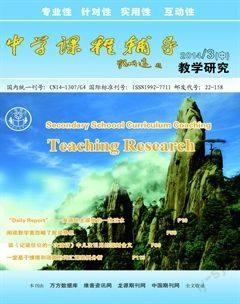情态动词表示推测的用法
徐琼
摘要:情态动词的用法多而杂,并随语境和说话人立场态度的变化而变化,是语言交际中的重点,也是应试中的难点。本文以情态动词表示推测为切入点,详细阐述了作推测性用法的情态动词的句法特征和句型结构,并通过例句的讲解,旨在帮助学生理解情态动词表示推测的用法。
关键词:情态动词;推测;句式
中图分类号:G632.0 文献标识码:A 文章编号:1992-7711(2014)03-0126
情态动词表示猜测是湖北省高考完成句子中的小众考点,但由于牵涉到对不同时间发生的事情进行推测,学生在答题时往往会因此而出错。为了更好地帮助复习备考,笔者现将情态动词表示猜测和情态动词+have done的用法总结如下:
一、对现在(某状态或某种判断)的推测
1. 主语+must ...:表示肯定的推测,只用于肯定句。常被翻译为“一定/准/肯定...”。
例:Its the office! So you must know eating is not allowed here.
2. 主语+can not ...:表示否定的推测,用于否定句。完成句子考题中常译为“一定不/肯定不/不可能……”。
例:He cant be in the classroom now. I met him on the playground just now.
3. 主语+Can 主语……?:表示疑问的推测,用于疑问句。常被译为“可能……吗?”
例:Mr Bush is on time for everything. How can it be that he was late for the meeting?
4. 主语+may/might ...:表示不太肯定的推测,用于肯定句。常见汉语翻译是“可能/或许……”。
例:The traffic is so heavy these days. I might arrive a bit late, so could you save me a place?
5. 主语+may/might not ...:表示不太肯定的推测,用于否定句。常见汉语翻译是“可能不/或许不”。
例:- Is John coming by train? -He should, but he may not. He likes driving his car.
may/might在表示推测时may 和might 没有太大区别,只是may的可能性更大。
二、对现在(或将来)正在发生的行为进行的推测
1. 句式“主语+must be doing...”:用于肯定句。常译为“一定是在/准是在/肯定是在做某事”。
例:I must be going now.(对即将发生的行为进行的猜测)
句式“主语+can not be doing ...”:用于否定句。常翻译成““一定不是在/不可能在做某事”。
例:He cant be working now.
3. 句式“Can 主语 be doing ...”:用于疑问句。常见意思是“可能正在做某事吗?”
例:Can he be sleeping?
4. 句式“主语+may/might be doing ...”:用于肯定句。常译为“可能/或许在做某事”。
“may/might not be doing ...”:用于否定句。常译为“可能/或许不在做某事”。
例:We may be playing tennis at nine tomorrow. (对将来正在发生的行为进行的猜测)
He may/might not be sleeping.
三、情态动词+have done的总结
1. 对过去发生的行为进行推测
(1)句式“主语+must have done ...”:表示肯定,用于肯定句。常译作“准是/一定/肯定做了某事”。
例:Since nobody gave him any help, he must have done the research on his own.
(2) “主语+cant/couldnt have done ...”:表示否定,用于否定句。常译为“不可能做过某事/肯定没做过”。(cant和couldnt在此时没有区别)
句式“Can/could+主语+ have done...”:表示否定、疑问,用于疑问句。常见汉语翻译是“可能/或许做了某事吗?”(can和could在此时没有区别)
例:Why are your eyes so red? You cant/couldnt have slept well last night.
There is no light in the room. Can/Could they have gone out?
(3)句式“主语+may / might/could have done...”:表示怀疑、不太肯定,用于肯定句。常译为“也许/或许/可能已经做了某事”。(may, might, could在此时没有区别)
例:It is possible that the King of Stonehenge was linked to the stones: he may have had a hand in planning the monument, or in helping transport and pull up the stones.
(4)句式“主语+may / might not have done...”:表示怀疑、不太肯定,用于否定句。常译为“也许/或许/可能没有做过某事”。(may和might在此时没有区别,但could不能用于此结构)
例:We should keep our test scores a secret, because it shows more respect for students who might not have done so well.
2. 在虚拟语气中的应用
(1)would have done ...:表示与过去事实相反的假设。常译为“就会……”。
例:-Do you think George has passed the driving test?
-No. If so, he would have driven his car to our college yesterday.
(2)could (not) have done ...:表示与过去事实相反的假设。常译为“本来能够/可以(不可能)做某事”。(在此can不能替换could)
例:We could have caught the flight, but we were caught in the traffic jam.
Had he been more careful, he couldnt have fallen in the exam.
(3)might have done...:表示与过去事实相反的假设。常译为“本来可以做某事(含有轻微的责备语气)”。
例:You might have given him more help, though you were busy.
3. 其他情态动词+have done
(1)should (not) have done ...:本来(不)应该做而实际没有做/做了某事。(ought to也有此用法)
例:I shouldnt/ought not to have watched that movie-it will give me horrible dreams.
(2)neednt have done...:本来不必做某事而实际上却做了。(多见否定句)
例:The weather turned out to be fine yesterday. I neednt take the trouble to carry my umbrella with me. (06江西)
(3)had better (not) have done ...:用于事后的建议,含轻微责备的口吻。肯定句常译为“当时最好做了某事”,否定句常译为“最好没做过某事”。
例:You had better have started earlier.
You had better not have scolded her.
(4)would rather (not) have done ...:表示对做过的事情的反悔。肯定句常译为“宁愿当时做了某事”,否定句常译为“宁愿当时没做过某事”。
例:I would rather have taken his advice.
I raised objections at the meeting, but now I would rather not have done that.
情态动词表示的情感意义虽然比较复杂,但只要抓住“多体会,悟语境,背例句”这个宗旨,再复杂的题目也可以迎刃而解。
(作者单位:湖北省武汉市新洲区第一中学 431400)

